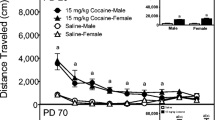Summary
-
1.
The regional developmental appearance of mu binding sites in rat brain was examined by quantitative autoradiography of3H-dihydromorphine binding in rats 2, 14, 21, and 28 days old.
-
2.
Labeling with3H-dihydromorphine was heterogeneous in adult rat brains, as previously reported by other laboratories. Levels of3H-dihydromorphine binding ranged from approximately 250 nCi/g tissue in the interpeduncular nucleus and 100 nCi/g tissue in the habenula to 40 nCi/g tissue in the hypothalamus and periaqueductal gray. Some areas, particularly white matter regions, had no detectable specific binding.
-
3.
The density of3H-dihydromorphine binding increased in all regions between 2 and 28 days of age.
-
4.
The increases in3H-dihydromorphine binding in various regions of rat brain developed at different rates. Maximal densities were seen by 14 days of age in most regions examined, including the caudate, hippocampus, amygdala, and hypothalamus. Binding in the medial thalamus and quadrigeminal plate, however, did not reach maximal levels until 21 days.
-
5.
Although quantitative autoradiography offers major advantages in the examination of the regional distribution of opiate binding sites, variability both between sections from the same brain and between sections from different brains demonstrate some of the difficulties associated with this type of experimental approach.
Similar content being viewed by others
References
Atweh, S. F., and Kuhar, M. J. (1977a). Autoradiographic localization of opiate receptors in rat brain. I. Spinal cord and lower medulla.Brain Res. 12453–57.
Atweh, S. F., and Kuhar, M. J. (1977b). Autoradiographic localization of opiate receptors in rat brain. II. The brain stem.Brain Res. 1291–12.
Atweh, S. F., and Kuhar, M. J. (1977c). Autoradiographic localization of opiate receptors in rat brain. III. The telencephalon.Brain Res. 134393–405.
Coyle, J. T., and Pert, C. B. (1976). Ontogenetic development of3H-naloxone binding in rat brain.Neuropharmacology 15555–560.
Garcin, F., and Coyle, J. T. (1976). Ontogenetic development of3H-naloxone binding and endogenous morphine-like factor in rat brain. InOpiates and Endogenous Opioid Peptides (H. W. Kosterlitz, Ed.), Elsevier/North Holland Press, Amsterdam.
Goodman, R. R., and Pasternak, G. W. (1985). Visualization of mu1 opiate receptors in rat brain by using a computerized autoradiographic subtraction technique.Proc. Nat. Acad. Sci. USA (in press).
Goodman, R. R., Snyder, S. H., Kuhar, M. J., and Young, W. S. (1980). Differentiation of delta and mu opiate receptor localizations by light microscopic autoradiography.Proc. Natl. Acad. Sci. USA 776239–6243.
Goodman, R. R., Houghten, R. A., and Pasternak, G. W. (1982). Autoradiography of3H-B-endorphin binding in brain.Brain Res. 288334–337.
Kent, J., Pert, C. B., and Herkenham, M. (1982). Ontogeny of opiate receptors in rat forebrain: Visualization by in vitro autoradiography.Dev. Brain Res. 2487–504.
Leslie, F. M., Tso, S., and Hurlbut, D. E. (1982). Differential appearance of opiate receptor subtypes in neonatal rat brain.Life Sci. 311393–1396.
Pasternak, G. W. (1981). Opiate, enkephalin and endorphin analgesia: Relations to a single subpopulation of opiate receptor.Neuroloyy 311311–1315.
Pasternak, G. W., Childers, S. R., and Snyder, S. H. (1980a). Opiate analgesia: Evidence for mediation by a subpopulation of opiate receptors.Science 208514–516.
Pasternak, G. W. Childers, S. R., and Snyder, S. H. (1980b). Naloxazone, a long-acting opiate antagonist: Effects in intact animals and on opiate receptor binding in vitro.J. Pharmacol. Exp. Ther. 214455–462.
Pasternak, G. W., Zhang, A. Z., and Tecott, L. (1980c). Developmental differences between high and low affinity opiate binding sites: Their relationship to analgesia and respiratory depression.Life Sci. 271185–1190.
Pert, C. B., Kuhar, M. J., and Snyder, S. H. (1976). Opiate receptor: Autoradiographic localization in rat brain.Proc. Natl. Acad. Sci. USA 733729–3733.
Tsang, D., Ng, S. C., and Ho, K. P. (1982). Development of methionine-enkephalin and naloxone binding sites in regions of rat brain.Dev. Brain Res. 3637–644.
Wohltmann, M., Roth, B. L., and Coscia, C. J. (1982). Differential postnatal development of mu and delta opiate receptors.Dev. Brain Res. 3679–684.
Zhang, A. Z., and Pasternak, G. W. (1981). Ontogeny of opioid pharmacology and receptors: High and low affinity site differences.Eur. J. Pharmacol. 7329–40.
Author information
Authors and Affiliations
Rights and permissions
About this article
Cite this article
Recht, L.D., Kent, J. & Pasternak, G.W. Quantitative autoradiography of the development of mu opiate binding sites in rat brain. Cell Mol Neurobiol 5, 223–229 (1985). https://doi.org/10.1007/BF00711008
Received:
Accepted:
Issue Date:
DOI: https://doi.org/10.1007/BF00711008




